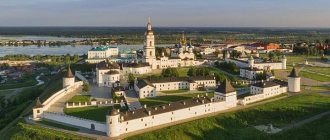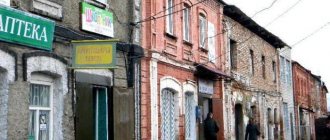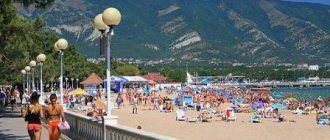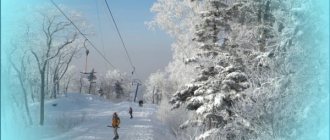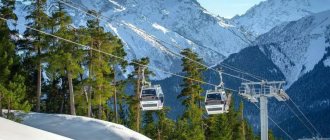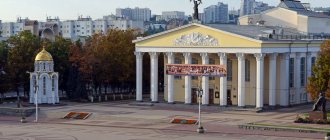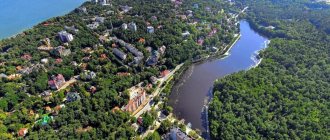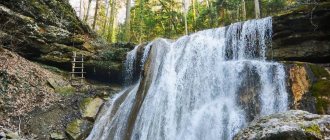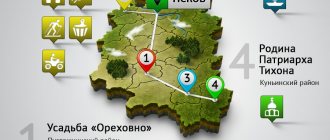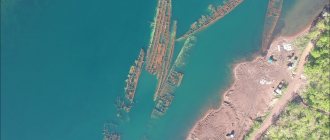A city near the southern spurs of the Khibiny
The history of Kirovsk began less than a century ago with the discovery of a large deposit of apatite-nepheline ores. At first the workers' settlement was called Khibinogorsk, and since 1934 - Kirovsky. Now 26 thousand people live here, and a large enterprise, Apatit, operates here.
The small town in the center of the Kola Peninsula is known as one of the oldest centers of domestic mountain and ski tourism. Kirovsk has good infrastructure, it’s easy to get here, so there are no fewer tourists in Khibiny in winter than in summer.
Monuments and sculptures of Kirovsk
Almost all the monuments of Kirovsk were erected in honor of people who at different times worked for the benefit of the city and the country.
Monument to the fallen Kirov residents
- Coordinates: 67.589962, 33.666452.
During the Great Patriotic War, the small northern town became one of the polar centers of resistance to the German invaders. Hundreds of Kirov residents were killed on the battlefields, on land and at sea.
After the victory, the memory of the defenders of the Motherland was immortalized by a large memorial. In the center stands a red and white stele decorated with stars, and behind there is a wide wall dotted with the names of fallen townspeople.
Monument to the First Builders
- Address: st. Kondrikova, 5.
Another mournful monument is dedicated to the builders who died during the construction of Kirovsk. In the first half of the 20th century, thousands of political prisoners and dispossessed peasants were transported to work in the tundra. At first, special settlers made up the majority of the city's population. Living conditions in the mountainous region were difficult and dangerous; tragedies occurred more than once in the Khibiny Mountains.
In December 1935, four avalanches came down from the mountains in a row, streams of snow demolished two apartment buildings in the village of Kukisvumchorr. Almost a hundred residents were buried under tons of snow, 89 of them, including 17 children, died. The victims of the disaster were buried at the 16th Kilometer cemetery, which is located near the highway leading from Kirovsk to Apatity.
In 1938, another mass grave appeared next to the burial: another avalanche destroyed the canteen in the mine and killed more than 20 specially displaced miners. In the mid-2000s, the Khibiny Memorial Society erected a sign over the graves in memory of the first builders. Every year, memorial events are held at the plaques with the names of the victims.
Monument to V.I. Kondrikov
- Address: st. Kondrykova, 4A.
Vasily Kondrikov, like Sergei Kirov, lived a short but eventful life and made an invaluable contribution to the founding and development of northern Kirovsk. The talented banker, on the recommendation of Kirov, became the first director of the Apatite trust, developed the apatite industry in the region and supervised the construction of Kirovsk and Monchegorsk.
Despite his numerous achievements and status as a holder of the Order of Lenin, in 1937 Vasily Ivanovich was arrested following a denunciation and executed on the same day. In an instant, the director's 4-year-old son became an orphan, and his young wife Inna Lazarevna became a widow. The wife was subjected to repression as the wife of an enemy of the people and spent 8 years in camps in Kolyma. The victims of the regime were rehabilitated only in 1955.
Kirov residents rightfully consider Kondrikov the founder of the city. One of the streets of Kirovsk received his name. In 2004, a bronze bust of Vasily Ivanovich appeared in the park in the city center. In 2015, the monument was dismantled and a residential building began to be built in its place. The announced restoration lasted for four years; the monument was restored in the fall of 2022 and installed on Kondrikova Street.
Snow village
Everyone who comes to Kirovsk in winter goes to the “Snow Village” at the foot of Mount Vudyavrchorr. A unique structure made of the purest polar snow and ice appears on the outskirts of the city with the onset of cold weather and operates until spring.
“Snow Village” is not separate buildings and courtyards. Since 2008, large tunnels with halls and passages have been built near the Tirvas sanatorium and health complex. The huge complex occupies more than 2000 square meters. m and is recognized as the largest structure in Russia made of snow.
Amazing sculptures, compositions and carved bas-reliefs of snow and ice are created by professional artists from different parts of Russia, so the design of the “Snow Village” looks wonderful. Under the backlit snow arches you get great photos.
The entertainment complex has cheesecake slides, a funny family attraction “Long Skis” and an excellent warm cafe with panoramic views of the mountains. Everyone can ride on a “banana” behind a snowmobile.
In the winter season 2020-2021, tickets cost 800 rubles for adults and 400 rubles for children. On the Snow Village website, tickets are sold at a 50% discount. A taxi from the city center to an unusual village will cost 250 rubles.
Natural attractions of Kirovsk and its surroundings
Kirovsk is located in one of the most picturesque corners of the Kola Peninsula. The city is surrounded by beautiful reservoirs, fast rivers and snow-covered mountain peaks. There are ski resorts on the slopes of the nearby mountains, thanks to which it is considered one of the best resorts in the Murmansk region.
Mount Kukisvumchorr
- GPS coordinates: 67.725481, 33.656302.
The mighty Kukisvumchorr is the largest peak of the Khibiny, its height is more than 1140 meters. The complex name translated from the Sami language means “mountain by a long valley.” The steep slopes are covered with plants typical of forest-tundra, and on the northern side there are two glaciers. Kukisvumchorr is a restless mountain; avalanches periodically descend from it.
At the foot of the mountain there is a microdistrict of the same name, which before being included in the city was a separate independent village. There is a ski complex on the mountain. There are six trails of varying degrees of difficulty, three rope tows and a baby lift on the slopes. Also on the mountain every year there is a stage of freeride competitions.
Mount Aykuaivenchorr
- Coordinates: 67.609837, 33.768781.
Another peak of the Khibiny massif is known for its unusual shape, which resembles the figure of a lying woman. The Sami name can be roughly translated into Russian as “mountain with the head of a goddess.” There is a preparatory ski complex on the southern and northern slopes of Aykuayvenchorr.
The Bolshoy Vudyavr complex has seven different lifts, several trails for skiing and snowboarding, and even freestyle ski jumps. Some trails are intended for beginners, while others are suitable only for experienced athletes.
Lake Bolshoi Vudyavr
- Coordinates: 67.631504, 33.671689.
Kirovsk occupies one of the banks of a wonderful reservoir. The word “Vudyavr” in the name is Sami, translated into Russian it means “mountain lake”. The name fully corresponds to the lake: Bolshoi Vudyavr is covered on three sides by snow-capped mountain peaks. In an old book from the beginning of the 17th century there is also another, Russian name - “Vediozero”.
The reservoir is relatively small, its diameter is less than two kilometers. Three rivers flow into it from the north side, and the Belaya River originates from the south side. The lake is mostly fed by rain and melted snow water. At one time, Bolshoi Woodyavr watered the entire district, including the residents of Kirovsk. The reservoir is rich in fish; anglers are especially attracted to brown trout and char.
Lake Superior
- Coordinates: 67.610457, 33.671390.
On the territory of the city there is a lake, which is significantly smaller in size than Bolshoy Vudyavr. The tiny pond has an oval shape. The embankment is well-maintained and therefore perfect for walking. Paths were laid along the shore, railings and lanterns were installed. On the southern side, a long pier pierces the water surface. During the warm season, a tall fountain gushes in the center of the lake.
Waterfall Beautiful
- Coordinates: 67.795135, 33.616106.
18 kilometers from the city there is a picturesque waterfall with the telling name Beautiful. The height of this beautiful creation of nature reaches 20 meters. The waterfall is located in a historical place - not far from the Kuelporr test site, where underground nuclear weapons tests were carried out in Soviet times.
Currently, the entrance to the dungeon is carefully walled up; local authorities claim that the level of radiation in the area is within normal limits, but tourists should be careful and refrain from picking mushrooms, berries and other gifts of nature. Interestingly, another name for the waterfall is Risjok, after the name of the river of the same name.
City Park
- Address: 50 Let Oktyabrya Street.
Little Kirovsk is surrounded on all sides by natural beauty, but in the city itself there is a green area for leisure of citizens and tourists. In the south-eastern part of Kirovsk, many years ago, an extensive cultural and recreation park was established.
Currently, the park cannot be called clean and cozy, but local authorities plan to transform it in the coming years, build children's playgrounds on the territory and organize a special area for walking dogs.
Botanical Garden
Everyone is surprised that a small town beyond the Arctic Circle has its own Polar-Alpine Garden. Exotic plants from the tropics and subtropics thrive in the spacious indoor greenhouse. As soon as you open the door, you find yourself surrounded by palm trees, bananas, palm trees, lemons and succulents. It's amazing to see coffee trees, ferns, bromeliads and tropical flowers when it's really cold in Kirovsk.
Next to the greenhouse there is a polar garden where local plants grow - spruce, birch, alder, as well as mosses and lichens typical of the Kola Peninsula. In the summer, guests of the Botanical Garden are guided along an ecological trail. Professional biologists work with tourists, so listening to a story about the polar flora is very interesting.
An excursion to the greenhouse costs 200 rubles, and along the ecological trail - 300 rubles.
Lakes Maly Vudyavr and Bolshoi Vudyavr
The reservoirs are connected by the Woodvyar River. The water complex is located just a few kilometers from the botanical garden. The lakes, which are surrounded on all sides by the Khibiny tundra, are very rich in various fish. Not only Russian tourists, but also foreign guests come to the northern regions to fish. There are plenty of cloudberries, blueberries, cranberries and lingonberries in the forest.
I’m very glad that there are several tourist centers scattered along the coast, so there will be no question of where to stay comfortably in the wild region.
Museum and exhibition
The Mineralogical Museum in the Arctic was created even before the war on the initiative of Academician Alexander Evgenievich Fersman. In 2013, an updated exhibition was opened in the center of Kirovsk, on Lenin Avenue, 4A. Old and new exhibits occupy the historic fire tower building - the clock tower. Local residents politely call it the cow's Big Ben.
Eight museum halls display models of mines for the extraction of apatite concentrate, replicas of mines, production machines, models of BELAZ trucks, antique telephones and mining tools. Tourists are introduced to the collection of Khibiny minerals, told about the geology of the Kola Peninsula and the history of the development of the Khibiny.
The museum is open daily from 9:00 to 21:00. Visits and excursions are free. Near the building there is a large block of ore and a funny monument to the miner.
Museum of History and Local Lore
On Sovetskaya Street, 9, in the village “25 km” there is a museum where you can get acquainted with the history of the city and the nature of the Kola Peninsula. Five halls display materials about the work of Kirov mines during the war, personal belongings of soldiers and letters from the front. The natural section displays stuffed northern animals and birds, things of geologists and the first samples of apatite-nepheline ore, which were discovered in the Khibiny Mountains in 1931. On the second floor there are paintings and graphic works by local artists.
The local history museum is open from Tuesday to Sunday from 10:00 to 17:30. Entrance costs 60-100 rubles.
Khibiny mountain range
There is a lot to see in the city and its surroundings. The Khibiny Mountains are called the pearl of Kirovsk. They are the largest and oldest massif on the entire Kola Peninsula. According to scientists, their geological age has “exceeded” 390 million years! They attract climbers with steep slopes, skiers with excellent European-level ski slopes, extreme sports enthusiasts with fast, deep rivers, and naturalists with valuable and rare flora.
The high season in the Khibiny lasts from mid-March to the end of April. The richest period for tourists is the period from late August to early March, when, having climbed one of the plateau-shaped peaks, you can observe the incredible beauty of the aurora up close.
Museum of Venedikt Erofeev
Kirovsk is associated with the childhood of the famous Russian writer Venedikt Erofeev. The author of the postmodern poem “Moscow-Petushki” was born in the suburb of Kandalaksha, but it was in Kirovsk that he spent his growing up years and studying at school.
The Literary Museum occupies only one room in the city library, on Lenin Avenue, 15. Many rarities are collected here - Erofeev’s manuscripts and books, old photographs and a gold medal that the future writer received for successfully completing school. Above the entrance hangs a map of the Moscow-Petushki route with explanatory inscriptions.
The museum is open on all days except Friday and Sunday, from 11:00 to 19:00.
Mysterious forest
If you come to Kirovsk with a child, go see the snow-covered wonders of the “Mysterious Forest”. The art park with this name is decorated with flickering lights, spectacular lighting and “cosmic” sculptures made of snow and concrete. On a snowy path it’s easy to feel like you’re in a fairy tale.
There is a cheesecake slide on site and a small cafe. The most interesting thing is to walk around the park at night.
“The Mysterious Forest” is located on the road to the southern slope of the “Bolshoi Vudyavr” ski resort. The turn off the highway between Kirovsk and Apatity is indicated by a sign.
The park is open from 15:00 to 21:00. Entrance for adults costs 600 rubles, and for children from 5 to 14 years old – 300 rubles. Children under 5 years old are admitted free of charge.
Temples and architectural monuments in Kirovsk
Kirovsk is less than a hundred years old, so there is not a single ancient building on its territory. Nevertheless, lovers of interesting architecture will find several interesting religious and civil buildings in the city and its surroundings.
Khibinogorsk Convent
- Address: Zheleznodorozhnaya st., 8.
Soon after the founding of Kirovsk, Soviet officials decided to turn the city into a “center of godlessness” and began to fight with all their might any manifestations of religiosity. It’s paradoxical, but it was here, back in Soviet times, that the first Orthodox church on the entire peninsula appeared.
The solution to this phenomenon is quite simple: the city was built not only by free citizens, but also by political prisoners from the Solovetsky camp, among whom there were many Orthodox Christians. Even in conditions of constant surveillance and hard work, believers found an opportunity to gather for joint prayer.
In 1946, at the entrance to the city, a chapel was built in honor of the Kazan Icon of the Mother of God. At the beginning of the 2000s, a female monastic community was formed at the temple, and in 2005 the monastery received official status. The Kirov Orthodox monastery is the northernmost on the planet.
Temple of the Savior Not Made by Hands
- Address: Solnechnaya st., 6.
The only parish church in Kirovsk was built in 2004 on the site of an old miners' settlement. The small five-domed brick building is painted in bright colors and is visible within a radius of several kilometers.
A small rectangular bell tower was built above the narthex, and a ramp for people with disabilities was equipped at the southern entrance. The territory of the church was landscaped through the efforts of the first rector and parishioners.
Chapel of St. Nicholas the Wonderworker
- GPS coordinates: 67.802471, 33.603592.
A small log chapel near the KSP Kuelporr mountain is the youngest religious building in the city. Construction of the structure began quite recently - in 2022. The idea to build a chapel belonged to the workers of the rescue point. The work was supervised by professional builder Alexander Shumsky.
The designer took into account the peculiarities of the local climate, so the wooden building was placed on a high stone foundation for greater reliability. In August 2022, priest Sergiy Krivovichev consecrated the dome crosses for the future church.
Train Station
- Address: Apatitovoe highway, 6.
On the border of the city, there is a curious monument of Soviet architecture that will especially delight lovers of “abandoned buildings.” In the middle of the tundra, at an abandoned railway station, there is a dilapidated station building. On the once beautiful building, columns and part of the letters from the name of the city have survived.
The history of the structure dates back to the times when ore mining began in the Khibiny Mountains, and a railway was built to Kirovsk. In 1939, the station opened a magnificent terminal lined with marble and granite. The waiting room was decorated with bronze chandeliers and a large-scale painting by I. Aivazovsky “The Ninth Wave”.
Many are still perplexed as to why the authorities decided to build such an expensive structure at such a difficult time. For a small, newly created town, a richly decorated building was an inappropriate luxury. There is a legend that the spectacular decor was intended for Joseph Stalin, who was supposedly going to come to Kirovsk.
According to another version, the station was supposed to be built not in Kirovsk, but in Kirov, but the builders or officials mixed up the names and arrived in the wrong city. One way or another, the structure was erected and served the northern town until the mid-90s. In 1996, the railway service closed and the station building was abandoned and turned into ruins after a fire.
Cinema "Bolshevik"
- Address: ave. Lenina, 12.
Since the founding of Khibinogorsk, local officials have taken care of the leisure of workers. In the 1930s, a cinema appeared in the growing city with a huge cinema hall with 1200 seats, a reading room, a room for playing checkers and chess, a shooting range and a buffet. In 1935, after the installation of special equipment, the institution became the first sound cinema in the region.
During Perestroika, the building turned into a shopping center, and in recent years it has been empty. The monument of Soviet architecture was recognized as an object of cultural heritage of the region. In 2022, the administration decided to restore Bolshevik as a cinema and cultural center.
Snowmobiling
One of the popular winter activities in Kirovsk is snowmobile tours. Almost all travel agencies in the city offer such services from December to March.
A one-day snowmobile trip for a group of 1-4 people costs 12,900 rubles. You will visit the “Snow Village”, a museum and exhibition, and climb Mount Aykuaivenchorr (1100 m).
Half-day snowmobile trips to the beautiful Ramsay Gorge - 4,000 rubles per person, to the wide valley of the Petrelius River - 4,500 rubles, to the top of Mount Takhtarvumchorr - 4,000 rubles and Mount Kaskasnyunchorr - 7,000 rubles.
Another tour of the Khibiny Mountains is designed for the whole day and lasts 11-12 hours. Tourists start near Lake Maly Vudyavr, drive on snowmobiles through the pass into the valley of the Kukisvumchorr hand to the Kuelporr base and return to Kirovsk. A winter trip costs 8,500 rubles per person.
Cross-country skiing and snowshoeing
The Khibiny Mountains are old and very picturesque mountains. While vacationing in Kirovsk in the winter months, tourists enjoy traveling on their own along spurs, gorges and through passes.
It is not necessary to bring equipment with you. At the Kola Expeditions snowmobile base, next to the Snow Village, they offer cross-country skis and poles for rental. Renting for an hour costs 150 rubles, for 2 hours – 200 rubles, for a day – 500 rubles, and for two or more days – 400 rubles per day. Snowshoe rental will cost 100 rubles per hour, 200 rubles for 2 hours and 500 rubles per day.
For independent hikes you need a map and good preparation. Winter Khibiny is an avalanche-prone area. To travel here, you need to understand which slopes an avalanche can come from and know how to use avalanche equipment. Daylight hours in the Arctic are short. Plan your route so that you can get down to your accommodation before dark.
Travel and accommodation
Now that you know where to go with friends or family in Kirovsk, let’s figure out how to get to Kirovsk and which hotels to choose. You can get to Kirovsk:
- By plane - the fastest and more or less affordable option. You can get to Apatit, where the Khibiny airport is located, from Moscow in just 2.5 hours, from there by transfer, taxi or regular bus (it runs very rarely!) to Kirovsk;
- by train - again you need to take a ticket to Apatit, from where you can get to your final destination according to a proven scheme;
- driving a car is a risky option. You can overcome the difficult roads of the Murmansk region only with an SUV. In addition, in Karelia there are large areas without gas stations, so you need to take several cans of gasoline on the road.
Hotels in Kirovsk, Murmansk region, offer guests comfortable accommodation in cozy rooms starting from 1,500 rubles per night. However, during high season you need to book in advance.
Dog sledding
If you have never ridden a husky and want to have fun with your children, choose active skating on frozen ice. Driving a sled makes you feel like a real musher!
Training and an independent walk of 1 km for adults costs 3,000 rubles, and for children under 14 years old – 1,800 rubles.
Experienced tourists in Kirovsk can ride a husky in the Khibiny Mountains. Fresh air, active movement and magnificent views charge you with positivity for the whole day. While one person drives the team, the rest ride on a banana behind the snowmobile. From time to time, tourists change roles, so everyone tries to control the team.
Mountain skiing costs 3,500 rubles for an adult and 2,000 rubles for a child under 14 years old. The price includes instruction, transfer and hot tea.
Ethnic excursions
The Kola Peninsula is the homeland of the Sami, a small people who have been herding reindeer for a long time. You can get acquainted with the Sami traditions and culture of the indigenous inhabitants of the Arctic in the Khibiny ethnopark. Tourists get to the place, ride a reindeer sleigh, play fun Sami football, shoot at targets with a bow and throw a lasso.
In conclusion, everyone drinks tea and eats fish and venison dishes in the tent. A 4.5 hour tour from Kirovsk costs 3,500 rubles for adults and 3,000 for children.
During a longer excursion, tourists are taken to the colorful Sami village of Lovozero. Participants watch national houses, play Sami games, ride down an ice slide and have lunch in the warm Petroglyphs cafe.
Travel for adults costs 4,700 rubles, and for children – 4,400 rubles.
Where to eat
Every year more and more restaurants are opening in Kirovsk, serving northern delicacies.
Cafe "Gamarjoba"
I recommend checking out the restaurants “Severny”, “At your plate”, “Gamarjoba” and “Bar Barevich”. In the first two, in addition to traditional cuisine, they serve dishes of venison, red fish, and desserts with cloudberries and cranberries. I recommend trying this.
In “Gamarjob”, as you guessed from the name, there are Georgian dishes: chakhokhbili, lula, lagman. Well, if you are an avid lover of roast beef and chateaubriand, Bar Barevich is for you.
The average bill at these restaurants is 1,200 rubles.

